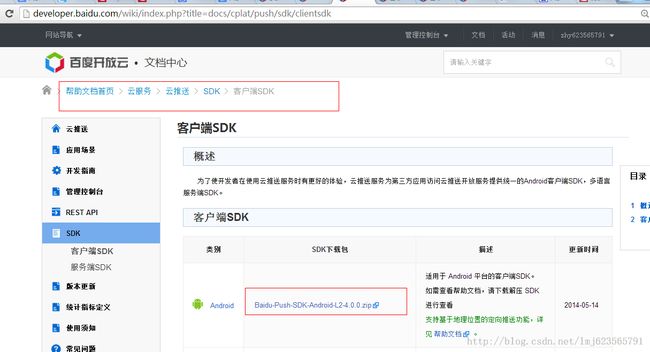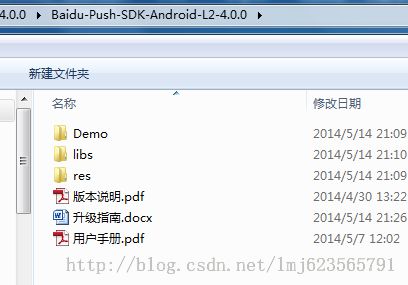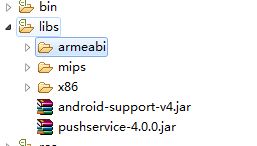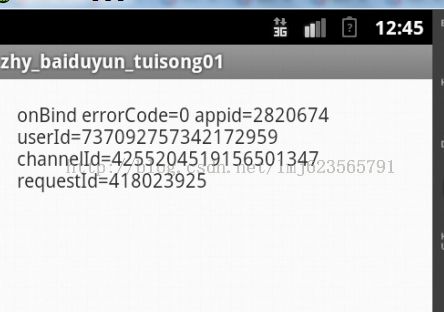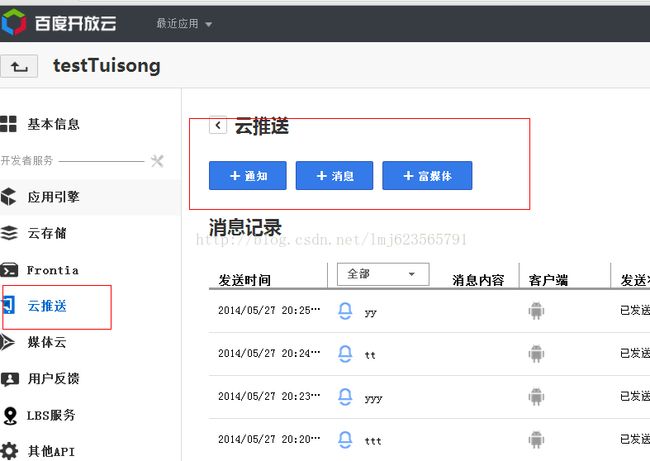Android推送 百度云推送 入门篇
转载请标明出处:http://blog.csdn.net/lmj623565791/article/details/27231237
现在app基本都有推送的功能,于是看了下百度云的推送,官方文档和Demo都很到位,记录下使用过程,目标是利用百度云推送最为服务器写个及时通讯的例子~当然了,这是第一篇入门~
1、第一步就是在百度开发者服务管理中创建项目,然后拿到API key , Secret Key ;这个过程就不多说了,上官网直接申请就行,不复杂。
2、下载云推送的客户端SDK,SDK的压缩文件中包含一个例子代码,一个用户手册,和所需的libs和资源等(其实直接看用户手册和Demo基本就没问题了)。
3、准备工作结束,接下来,我们就直接开始新建项目测试
a、新建一个项目,然后把SDK中的libs中的jar和so文件夹拷贝到新建的项目中去
b、将manifest中的application的name设置为:com.baidu.frontia.FrontiaApplication
- <application
- android:name="com.baidu.frontia.FrontiaApplication"
- android:allowBackup="true"
- android:icon="@drawable/ic_launcher"
- android:label="@string/app_name"
- android:theme="@style/AppTheme" >
如果你的项目需要自定义Application,请参考用户手册中的相关配置。
c、添加权限
- <uses-permission android:name="android.permission.INTERNET" />
- <uses-permission android:name="android.permission.READ_PHONE_STATE" />
- <uses-permission android:name="android.permission.ACCESS_NETWORK_STATE" />
- <uses-permission android:name="android.permission.RECEIVE_BOOT_COMPLETED" />
- <uses-permission android:name="android.permission.WRITE_SETTINGS" />
- <uses-permission android:name="android.permission.VIBRATE" />
- <uses-permission android:name="android.permission.WRITE_EXTERNAL_STORAGE" />
- <uses-permission android:name="android.permission.DISABLE_KEYGUARD" />
- <uses-permission android:name="android.permission.ACCESS_COARSE_LOCATION" />
- <uses-permission android:name="android.permission.ACCESS_WIFI_STATE" />
d、添加两个receiver和一个Service(注释标明了用处)
- <!-- push service start -->
- <!-- 用于接收系统消息以保证PushService正常运行 -->
- <receiver
- android:name="com.baidu.android.pushservice.PushServiceReceiver"
- android:process=":bdservice_v1" >
- <intent-filter>
- <action android:name="android.intent.action.BOOT_COMPLETED" />
- <action android:name="android.net.conn.CONNECTIVITY_CHANGE" />
- <action android:name="com.baidu.android.pushservice.action.notification.SHOW" />
- <action android:name="com.baidu.android.pushservice.action.media.CLICK" />
- </intent-filter>
- </receiver>
- <!-- Push服务接收客户端发送的各种请求 -->
- <!-- 注意:RegistrationReceiver 在2.1.1及之前版本有拼写失误,为RegistratonReceiver ,用新版本SDK时请更改为如下代码 -->
- <receiver
- android:name="com.baidu.android.pushservice.RegistrationReceiver"
- android:process=":bdservice_v1" >
- <intent-filter>
- <action android:name="com.baidu.android.pushservice.action.METHOD" />
- <action android:name="com.baidu.android.pushservice.action.BIND_SYNC" />
- </intent-filter>
- <intent-filter>
- <action android:name="android.intent.action.PACKAGE_REMOVED" />
- <data android:scheme="package" />
- </intent-filter>
- </receiver>
- <!-- Push 服务 -->
- <!-- 注意:在4.0 (包含)之后的版本需加上如下所示的intent-filter action -->
- <service
- android:name="com.baidu.android.pushservice.PushService"
- android:exported="true"
- android:process=":bdservice_v1" >
- <intent-filter>
- <action android:name="com.baidu.android.pushservice.action.PUSH_SERVICE" />
- </intent-filter>
- </service>
- <!-- push service end -->
e、我们需要自己实现一个Receiver,来接收Push消息、接口调用回调以及通知点击事件。
- <receiver android:name="com.example.zhy_baiduyun_tuisong01.receiver.MyPushMessageReceiver" >
- <intent-filter>
- <!-- 接收push消息 -->
- <action android:name="com.baidu.android.pushservice.action.MESSAGE" />
- <!-- 接收bind、setTags等method的返回结果 -->
- <action android:name="com.baidu.android.pushservice.action.RECEIVE" />
- <!-- 可选。接受通知点击事件,和通知自定义内容 -->
- <action android:name="com.baidu.android.pushservice.action.notification.CLICK" />
- </intent-filter>
- </receiver>
代码:
- package com.example.zhy_baiduyun_tuisong01.receiver;
- import java.util.List;
- import org.json.JSONException;
- import org.json.JSONObject;
- import android.content.Context;
- import android.content.Intent;
- import android.text.TextUtils;
- import android.util.Log;
- import com.baidu.frontia.api.FrontiaPushMessageReceiver;
- import com.example.zhy_baiduyun_tuisong01.MainActivity;
- import com.example.zhy_baiduyun_tuisong01.util.PreUtils;
- /**
- * Push消息处理receiver。请编写您需要的回调函数, 一般来说: onBind是必须的,用来处理startWork返回值;
- * onMessage用来接收透传消息; onSetTags、onDelTags、onListTags是tag相关操作的回调;
- * onNotificationClicked在通知被点击时回调; onUnbind是stopWork接口的返回值回调
- *
- * 返回值中的errorCode,解释如下:
- * 0 - Success
- * 10001 - Network Problem
- * 30600 - Internal Server Error
- * 30601 - Method Not Allowed
- * 30602 - Request Params Not Valid
- * 30603 - Authentication Failed
- * 30604 - Quota Use Up Payment Required
- * 30605 - Data Required Not Found
- * 30606 - Request Time Expires Timeout
- * 30607 - Channel Token Timeout
- * 30608 - Bind Relation Not Found
- * 30609 - Bind Number Too Many
- *
- * 当您遇到以上返回错误时,如果解释不了您的问题,请用同一请求的返回值requestId和errorCode联系我们追查问题。
- *
- */
- public class MyPushMessageReceiver extends FrontiaPushMessageReceiver {
- /** TAG to Log */
- public static final String TAG = MyPushMessageReceiver.class
- .getSimpleName();
- /**
- * 调用PushManager.startWork后,sdk将对push
- * server发起绑定请求,这个过程是异步的。绑定请求的结果通过onBind返回。 如果您需要用单播推送,需要把这里获取的channel
- * id和user id上传到应用server中,再调用server接口用channel id和user id给单个手机或者用户推送。
- *
- * @param context
- * BroadcastReceiver的执行Context
- * @param errorCode
- * 绑定接口返回值,0 - 成功
- * @param appid
- * 应用id。errorCode非0时为null
- * @param userId
- * 应用user id。errorCode非0时为null
- * @param channelId
- * 应用channel id。errorCode非0时为null
- * @param requestId
- * 向服务端发起的请求id。在追查问题时有用;
- * @return none
- */
- @Override
- public void onBind(Context context, int errorCode, String appid,
- String userId, String channelId, String requestId) {
- String responseString = "onBind errorCode=" + errorCode + " appid="
- + appid + " userId=" + userId + " channelId=" + channelId
- + " requestId=" + requestId;
- Log.e(TAG, responseString);
- // 绑定成功,设置已绑定flag,可以有效的减少不必要的绑定请求
- if (errorCode == 0) {
- PreUtils.bind(context);
- }
- // Demo更新界面展示代码,应用请在这里加入自己的处理逻辑
- updateContent(context, responseString);
- }
- /**
- * 接收透传消息的函数。
- *
- * @param context
- * 上下文
- * @param message
- * 推送的消息
- * @param customContentString
- * 自定义内容,为空或者json字符串
- */
- @Override
- public void onMessage(Context context, String message,
- String customContentString) {
- String messageString = "透传消息 message=\"" + message
- + "\" customContentString=" + customContentString;
- Log.e(TAG, messageString);
- // 自定义内容获取方式,mykey和myvalue对应透传消息推送时自定义内容中设置的键和值
- if (!TextUtils.isEmpty(customContentString)) {
- JSONObject customJson = null;
- try {
- customJson = new JSONObject(customContentString);
- String myvalue = null;
- if (customJson.isNull("mykey")) {
- myvalue = customJson.getString("mykey");
- }
- } catch (JSONException e) {
- // TODO Auto-generated catch block
- e.printStackTrace();
- }
- }
- // Demo更新界面展示代码,应用请在这里加入自己的处理逻辑
- updateContent(context, messageString);
- }
- /**
- * 接收通知点击的函数。注:推送通知被用户点击前,应用无法通过接口获取通知的内容。
- *
- * @param context
- * 上下文
- * @param title
- * 推送的通知的标题
- * @param description
- * 推送的通知的描述
- * @param customContentString
- * 自定义内容,为空或者json字符串
- */
- @Override
- public void onNotificationClicked(Context context, String title,
- String description, String customContentString) {
- String notifyString = "通知点击 title=\"" + title + "\" description=\""
- + description + "\" customContent=" + customContentString;
- Log.e(TAG, notifyString);
- // 自定义内容获取方式,mykey和myvalue对应通知推送时自定义内容中设置的键和值
- if (!TextUtils.isEmpty(customContentString)) {
- JSONObject customJson = null;
- try {
- customJson = new JSONObject(customContentString);
- String myvalue = null;
- if (customJson.isNull("mykey")) {
- myvalue = customJson.getString("mykey");
- }
- } catch (JSONException e) {
- // TODO Auto-generated catch block
- e.printStackTrace();
- }
- }
- // Demo更新界面展示代码,应用请在这里加入自己的处理逻辑
- updateContent(context, notifyString);
- }
- /**
- * setTags() 的回调函数。
- *
- * @param context
- * 上下文
- * @param errorCode
- * 错误码。0表示某些tag已经设置成功;非0表示所有tag的设置均失败。
- * @param successTags
- * 设置成功的tag
- * @param failTags
- * 设置失败的tag
- * @param requestId
- * 分配给对云推送的请求的id
- */
- @Override
- public void onSetTags(Context context, int errorCode,
- List<String> sucessTags, List<String> failTags, String requestId) {
- String responseString = "onSetTags errorCode=" + errorCode
- + " sucessTags=" + sucessTags + " failTags=" + failTags
- + " requestId=" + requestId;
- Log.e(TAG, responseString);
- // Demo更新界面展示代码,应用请在这里加入自己的处理逻辑
- updateContent(context, responseString);
- }
- /**
- * delTags() 的回调函数。
- *
- * @param context
- * 上下文
- * @param errorCode
- * 错误码。0表示某些tag已经删除成功;非0表示所有tag均删除失败。
- * @param successTags
- * 成功删除的tag
- * @param failTags
- * 删除失败的tag
- * @param requestId
- * 分配给对云推送的请求的id
- */
- @Override
- public void onDelTags(Context context, int errorCode,
- List<String> sucessTags, List<String> failTags, String requestId) {
- String responseString = "onDelTags errorCode=" + errorCode
- + " sucessTags=" + sucessTags + " failTags=" + failTags
- + " requestId=" + requestId;
- Log.e(TAG, responseString);
- // Demo更新界面展示代码,应用请在这里加入自己的处理逻辑
- updateContent(context, responseString);
- }
- /**
- * listTags() 的回调函数。
- *
- * @param context
- * 上下文
- * @param errorCode
- * 错误码。0表示列举tag成功;非0表示失败。
- * @param tags
- * 当前应用设置的所有tag。
- * @param requestId
- * 分配给对云推送的请求的id
- */
- @Override
- public void onListTags(Context context, int errorCode, List<String> tags,
- String requestId) {
- String responseString = "onListTags errorCode=" + errorCode + " tags="
- + tags;
- Log.e(TAG, responseString);
- // Demo更新界面展示代码,应用请在这里加入自己的处理逻辑
- updateContent(context, responseString);
- }
- /**
- * PushManager.stopWork() 的回调函数。
- *
- * @param context
- * 上下文
- * @param errorCode
- * 错误码。0表示从云推送解绑定成功;非0表示失败。
- * @param requestId
- * 分配给对云推送的请求的id
- */
- @Override
- public void onUnbind(Context context, int errorCode, String requestId) {
- String responseString = "onUnbind errorCode=" + errorCode
- + " requestId = " + requestId;
- Log.e(TAG, responseString);
- // 解绑定成功,设置未绑定flag,
- if (errorCode == 0) {
- PreUtils.unbind(context);
- }
- // Demo更新界面展示代码,应用请在这里加入自己的处理逻辑
- updateContent(context, responseString);
- }
- private void updateContent(Context context, String content) {
- Log.e(TAG, "updateContent");
- //String logText = "" + Utils.logStringCache;
- // if (!logText.equals("")) {
- // logText += "\n";
- // }
- // SimpleDateFormat sDateFormat = new SimpleDateFormat("HH-mm-ss");
- // logText += sDateFormat.format(new Date()) + ": ";
- // logText += content;
- //Utils.logStringCache = logText;
- Intent intent = new Intent();
- intent.putExtra("result", content);
- intent.setClass(context.getApplicationContext(), MainActivity.class);
- intent.addFlags(Intent.FLAG_ACTIVITY_NEW_TASK);
- context.getApplicationContext().startActivity(intent);
- }
- }
代码是官方Demo的代码,注释特别详细,做了一点修改,每次回调的结果,我会让显示到主界面上。主Actvity:
- package com.example.zhy_baiduyun_tuisong01;
- import android.app.Activity;
- import android.content.Intent;
- import android.os.Bundle;
- import android.util.Log;
- import android.widget.TextView;
- import com.baidu.android.pushservice.PushConstants;
- import com.baidu.android.pushservice.PushManager;
- import com.example.zhy_baiduyun_tuisong01.util.PreUtils;
- public class MainActivity extends Activity
- {
- private TextView mTextView;
- @Override
- protected void onCreate(Bundle savedInstanceState)
- {
- super.onCreate(savedInstanceState);
- setContentView(R.layout.activity_main);
- initView();
- autoBindBaiduYunTuiSong();
- }
- private void initView()
- {
- mTextView = (TextView) findViewById(R.id.id_textview);
- }
- @Override
- protected void onNewIntent(Intent intent)
- {
- String result = intent.getStringExtra("result");
- if (result != null)
- {
- mTextView.setText(result);
- }
- // super.onNewIntent(intent);
- }
- /**
- * 如果没有绑定百度云,则绑定,并记录在属性文件中
- */
- private void autoBindBaiduYunTuiSong()
- {
- if (!PreUtils.isBind(getApplicationContext()))
- {
- PushManager.startWork(getApplicationContext(),
- PushConstants.LOGIN_TYPE_API_KEY,
- "TVkKGesssSDs5q7AamLGnNCs");
- }
- }
- }
最终的测试:
1、应用安装后,如果绑定成功,主界面:
然后在管理控制台开始分别发送通知和消息:
2、当发送通知并点击通知:
3、当发送消息:
好了,都是最基本的功能,没什么技术含量就是需要点耐心,下面贴上源码,使用源码请把MainActivity里面的KEY设置成自己申请的KEY。
源码点击下载

